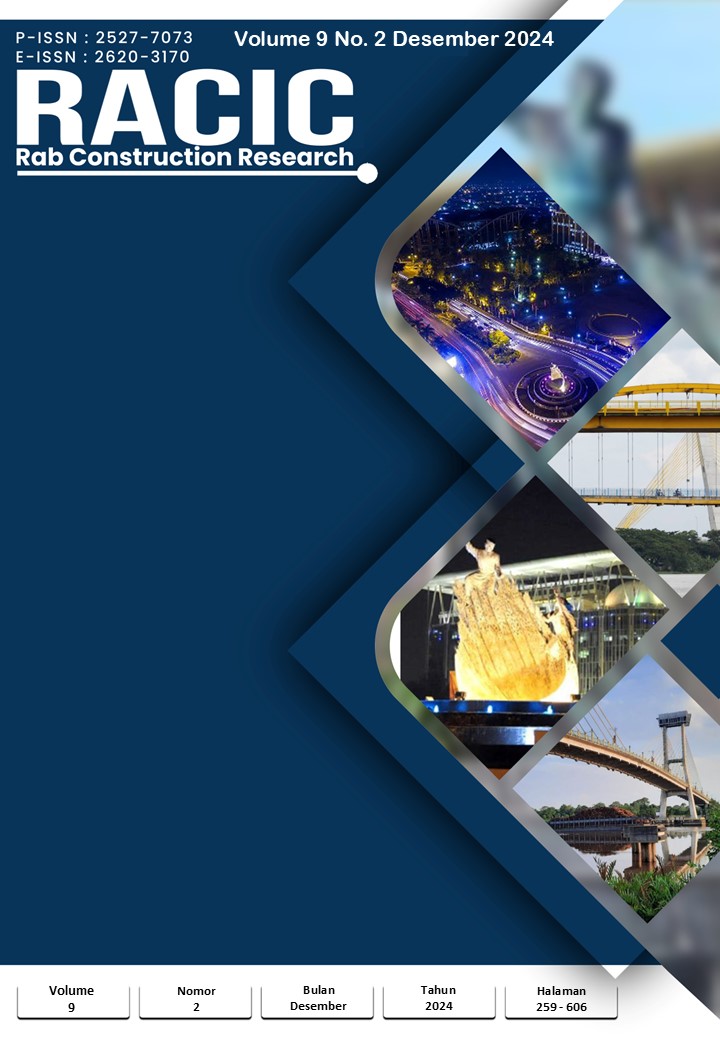ANALISIS METODE NILAI HASIL (EARNED VALUE) MENGGUNAKAN SIMULASI MONTE CARLO UNTUK MONITORING PROYEK PEMBANGUNAN JALAN
DOI:
https://doi.org/10.36341/racic.v9i2.4253Keywords:
Performance; Earned Value Concept; Monte Carlo Simulation; Merit ReviewAbstract
Project performance is assessed based on schedule, cost, and quality. Time and cost measurements must be carried out regularly to identify if there is a discrepancy with the plan. In the XYZ road construction project in East Java Province, a deviation of 20.707% was found in the 19th week, so it is necessary to analyze the concept of the value of results to determine the future development of the project. To analyze the spread of project uncertainty, Monte Carlo simulation is used by modeling the system with random numbers. The random number generated is the number between the minimum and maximum RAB for each type of work in the project. After repetition according to the number of iterations obtained with a relative error value of 2%. Then the frequency graph and normal distribution are analyzed, so it can be seen that the project must provide costs of Rp 11,031,591,805.11, Rp 16,742,117,603.03, and Rp 21,981,246,725.01 for performance evaluation at 50%, 75%, and 100% performance reviews. The SPI calculation result in week 19 is 0.409, indicating that the project is behind schedule. In addition, the TE calculation shows this project can be completed in 508 days or 73 weeks.
Downloads
References
M. Priyo and N. A. Wibowo, “Konsep Earned Value dalam Aplikasi Pengelolaan Proyek Konstruksi,†J. Ilm. Semesta Tek., vol. 11, no. 2, pp. 153–161, 2008, [Online]. Available: https://journal.umy.ac.id/index.php/st/article/download/763/908
I. Meliasari, M. Indrayadi, and Lusiana, “Earned Value Analysis Terhadap Biaya dan Waktu pada Proyek Konstruksi (Studi Kasus Proyek Pembangunan Sarana/Prasarana Pengamanan Pantai),†JeLAST J. Tek. Kelautan, PWK, Sipil, dan Tambang, vol. 2, no. 2, pp. 1–11, 2013, doi: 10.26418/jelast.v2i2.3982.
R. Gumelar, “Analisis Metode Monte Carlo pada Konsep Nilai Hasil untuk Monitoring Proyek,†J. Mhs. Jur. Tek. Sipil, vol. 1, no. 1, 2015, [Online]. Available: http://sipil.studentjournal.ub.ac.id/index.php/jmts/article/view/203
M. W. L. Bulo, R. Balaka, and R. Sriyani, “Pengaplikasian Metode Earned Value Pada Pengendalian Waktu Terhadap Biaya (Studi Kasus: Proyek Penggantian Jembatan Sungai Langklome Cs Kabupaten Muna),†STABILITA J. Ilm. Tek. Sipil, vol. 1, no. 3, pp. 359–372, 2014, doi: 10.55679/jts.v1i3.6753.
M. I. Maromi and R. Indryani, “Metode Eraned Value untuk Analisa Kinerja Biaya dan Waktu Pelaksanaan pada Proyek Pembangunan Condotel De Vasa Surabaya,†J. Tek. ITS, vol. 4, pp. 54–59, 2015, doi: 10.12962/j23373539.v4i1.8970.
Y. A. Messah, L. H. P. Lona, and D. A. T. Sina, “Pengendalian waktu dan biaya pekerjaan konstruksi sebagai dampak dari perubahan desain (Studi Kasus Embung Irigasi Oenaem, Kecamatan Biboki Selatan, Kabupaten Timor Tengah Utara),†J. Tek. Sipil, Univ. Nusa Cendana Kupang, vol. II, no. 2, pp. 121–132, 2013, [Online]. Available: http://jurnalmanajemen.petra.ac.id/index.php/jurnal-teknik-sipil/article/view/18950
A. Fadjar, “Monte Carlo Simulation Application in Project Cost Estimation,†SMARTek, vol. 6, no. 4, pp. 222–227, 2008, [Online]. Available: http://jurnal.untad.ac.id/jurnal/index.php/SMARTEK/article/view/486
A. De Marco, Project Management for Facility Construction : A Guide for Engineers and Architects, Second Edition, 2nd ed. Turin: Springer, 2018. doi: 10.1007/978-3-319-75432-1.
Z. R. Kamandang, S. El Unas, and K. P. Negara, “Penilaian Risiko Finansial dengan Menggunakan Simulasi Monte Carlo (Studi Kasus Gedung STIKES Maharani Malang),†J. Mhs. Jur. Tek. Sipil, vol. 1, no. 2, pp. 286–297, 2014, [Online]. Available: http://sipil.studentjournal.ub.ac.id/index.php/jmts/article/view/51
Downloads
Published
Issue
Section
License
1. Copyright of all journal manuscripts is held by the RACIC : Rab Construction Research
2. Formal legal provisions to access digital articles of electronic journal are subject to the provision of the Creative Commons Attribution-ShareAlike license (CC BY-NC-SA), which means that RACIC : Rab Construction Research is rightful to keep, transfer media/format, manage in the form of databases, maintain, and publish articles.
3. Published manuscripts both printed and electronic are open access for educational, research, and library purposes. Additionally, the editorial board is not responsible for any violations of copyright law.
licensed under a Creative Commons Attribution-ShareAlike 4.0 International License.






